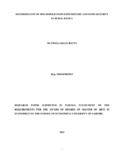| dc.description.abstract | During the period after independence in Kenya, the government’s dominance in the production and marketing of goods and services held back development of the private sector due to its inability to continuously support food production financially and technically. As such, there was a decline in agricultural growth and development as a whole. The purpose of food self-sufficiency in Kenya was to a large extent attained in the early years of independence until the late seventies after which massive food shortages set in partly because of low government support for agriculture and rural development and severe droughts according to (Fernando, 2013). In the 1980’s, production of main food commodities began to increase reaching very high levels in 1987 and worsened in 1988, a decline which was attributed to poor price incentives and drought but in 2011, from its own production, Kenya could feed 88% of its population. With 80% of the population living in the rural areas and agriculture being the main economic activity, a third of the country’s population is food insecure and over 10 million people are suffering from chronic food insecurity. It’s on this basis that this study examined the determinants of household food expenditure in rural Kenya by the use of secondary data obtained from the Kenya Integrated Household Budget Survey by the Kenya National Bureau of Statistics. The specific objectives of the study are: To analyze the expenditure patterns in rural Kenya; to determine the food security situation in rural Kenya and to determine how of household food expenditure affects food security in rural Kenya. Ordinary least squares were used in the estimation of the relationship amongst the variables under study and data was analyzed using Stata. The findings were that the education level of the household head, household size and household income level were positive and statistically significant in determining food expenditure at 5% level of significance and the shortcomings were that the study could not utilize current data which is now being collected by KNBS for 2015. However, the study recommended use of recent data to investigate if there are other factors affecting household food expenditure and food security in rural Kenya. | en_US |

